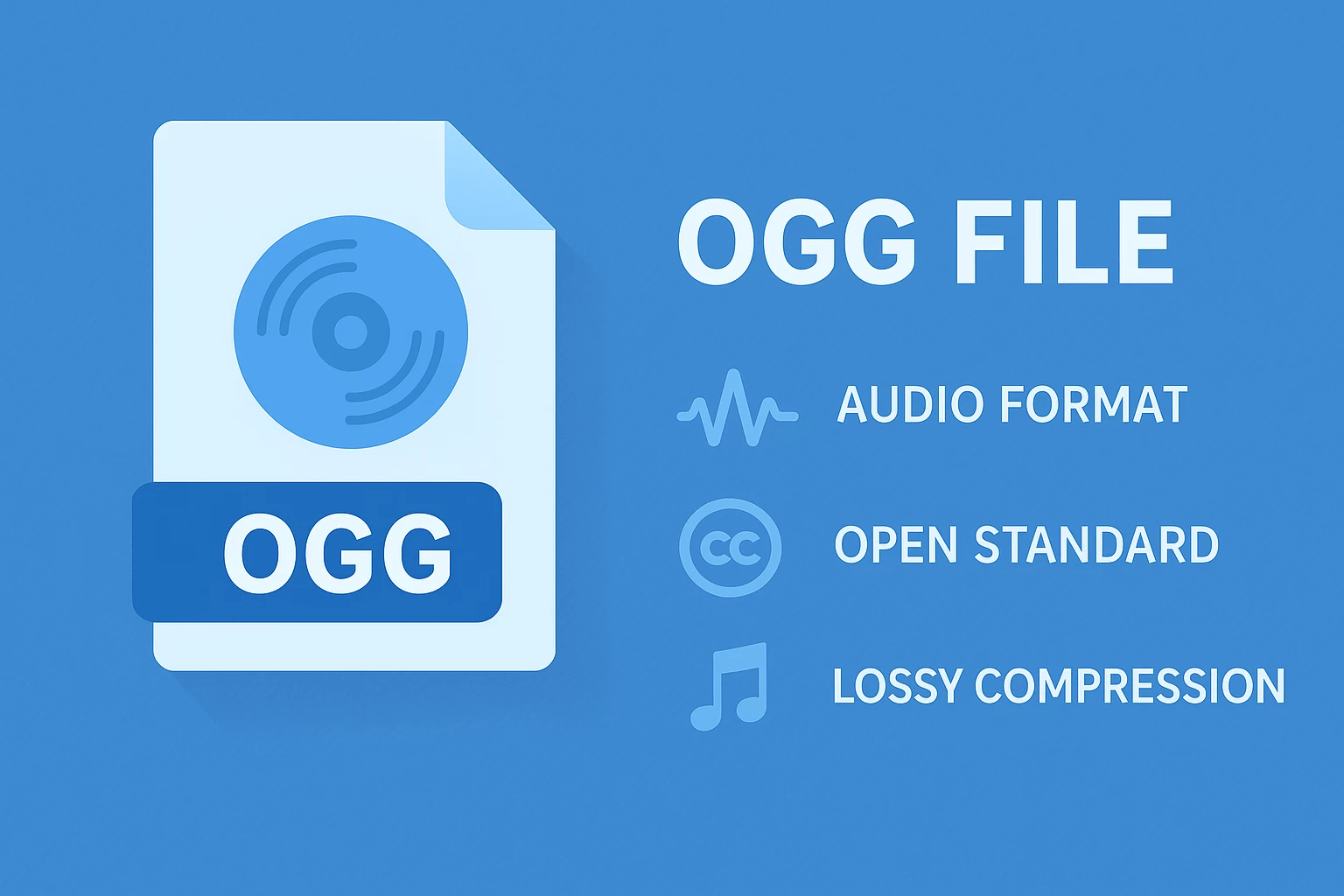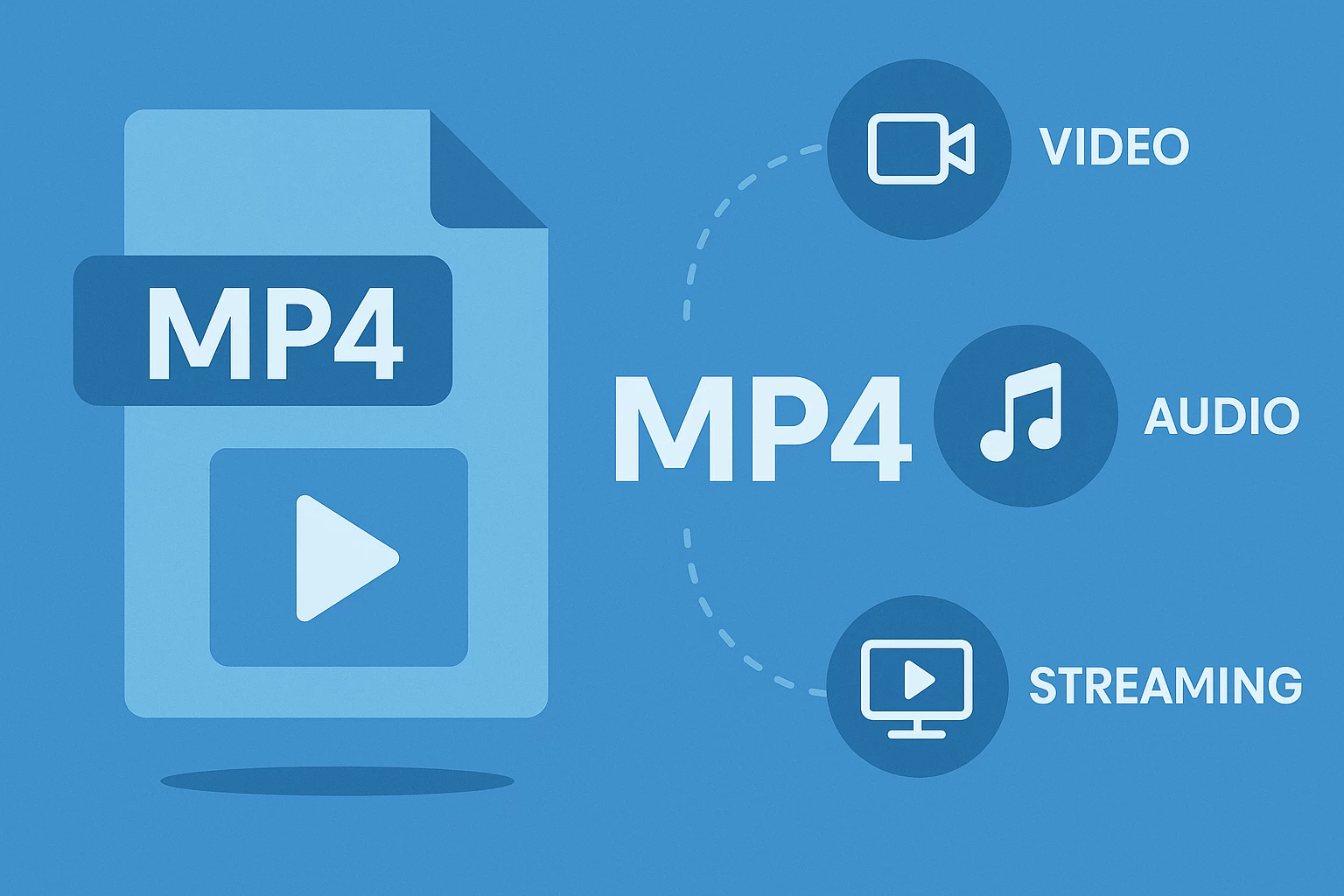
What Is an MP4? A-to-Z Guide for 2025
MP4 has become the universal language of video. Every time we stream a movie, record a short clip, or download content online, we’re most likely dealing with an MP4 file.
What I find impressive about MP4 is its flexibility. It handles everything from 4K movies to quick social media clips without breaking quality or playback performance.
Similarly, it stores video, audio, subtitles, and even metadata in one efficient package, making it ideal for both professionals and everyday users.
In my article, I’ll explore what the MP4 format really is, how it works, and why it continues to dominate modern video production and streaming.
I’ll also cover its advantages, limitations, and the new role it plays in AI-powered content creation and cloud-based platforms in 2025. Stick with me to learn how to use MP4 effectively & keep your videos secure and optimized.

The Basics of MP4 Format#
MP4 is the video format I use most often because it works everywhere and keeps files light without sacrificing quality. It can store video, audio, subtitles, and metadata in one file, which makes it perfect for editing, streaming, and sharing.
The format relies on efficient compression methods such as H.264 and H.265 to reduce file size while keeping the picture clear. That balance between performance and quality is the reason MP4 remains the global standard for digital video.
Its compatibility is another major strength. MP4 plays smoothly on computers, phones, browsers, and smart TVs, so I never worry about playback issues or conversion. It’s simple, reliable, and flexible enough for nearly any use.
In short, MP4 combines storage efficiency, visual quality, and universal support better than any other video format available today.
Convert MP4 to Other Formats with MConverter
What MP4 Stands For#
MP4 stands for MPEG-4 Part 14, a standard developed by the Moving Picture Experts Group (MPEG). It was designed as a container format that holds different types of media, video, audio, subtitles, and related data inside a single file.
Accordingly, its structure makes it adaptable to a wide range of devices and applications.
The Origins and History of MP4#
MP4 was first introduced in 2001, building on the structure of Apple’s QuickTime (.MOV) format. It was created to make video sharing and online streaming more practical without losing too much quality.
Over time, MP4 became the default choice for platforms such as YouTube, iTunes, and Netflix because of its efficiency and smooth playback.
Today, MP4 supports modern codecs, high-definition video, and multi-audio tracks, making it suitable for professional production and everyday use alike.
MP4 vs MPEG-4 - Clearing the Confusion#
Many people mix up MP4 and MPEG-4, but they are not the same. MPEG-4 refers to the method used to encode and compress audio and video, while MP4 refers to the container that stores them.

I think of MPEG-4 as the technology behind the compression and MP4 as the file format that delivers it. For example, a video might be encoded using an MPEG-4 codec but saved as an MP4 file for easier playback and sharing.
If you understand this difference, it helps me choose the right format settings when exporting or converting videos, especially when working with different devices or editing tools.
Also read: What Is a Mov File? Pros, Cons, and How to Use It
Technical Structure of an MP4 File#
MP4 might appear simple, but its internal layout is carefully designed to keep every part of the file organized and synchronized. Each element plays a specific role in maintaining smooth and efficient playback across all devices.
An MP4 file follows a container-based structure made up of small data units called atoms or boxes. Each atom holds a distinct type of information, such as video data, audio tracks, subtitles, or metadata. Together, the atoms define how the file is stored, accessed, and played.
The most important atom is moov, which stores timing and structure data. Without it, a video cannot play correctly. Another key atom is mdat, which contains the actual video and audio streams.
Others, such as ftyp, define the file type, while free reserves space for future edits or adjustments.

MP4 organizes content through a track system, where every media element, video, audio, or subtitles, exists on its own track within one file. The design makes it possible to include multiple languages, caption files, or different soundtracks without losing synchronization.
I picture MP4 as a digital storage box with separate compartments for every component. Each part stays neatly arranged yet connected, allowing fast navigation and reliable playback.
The structure also supports modern streaming methods. MP4 enables progressive playback, allowing viewers to start watching before the entire file loads. A newer version, fragmented MP4 (fMP4), divides content into smaller segments that stream efficiently across platforms such as YouTube or Netflix.
Even though the internal structure is complex, it gives MP4 its stability, compactness, and universal compatibility. It keeps multimedia files efficient, organized, and easy to play on any modern device.
Related article: What Is an Iso File? The Ultimate Guide for 2025
Advantages of the MP4 Format#
MP4 has earned its place as the most widely used video format because it combines flexibility, quality, and efficiency in a way few others can match. I rely on it for most video-related tasks since it works smoothly across platforms, compresses content without visible quality loss, and adapts easily to different devices and workflows.
One of its strongest benefits is efficient compression. MP4 uses advanced codecs such as H.264 and H.265 to reduce file size while preserving sharpness, color, and smooth motion. Smaller files make uploading, downloading, and streaming much faster, which is essential for online platforms and mobile devices.
Another major advantage is universal compatibility. MP4 plays seamlessly on nearly every device and operating system, including Windows, macOS, iOS, Android, and smart TVs. It integrates effortlessly into video players, browsers, and editing tools, so I never worry about playback errors or missing codecs.
The format also supports multiple media elements within a single file. MP4 can include video, audio, subtitles, and metadata together, keeping everything perfectly synchronized.
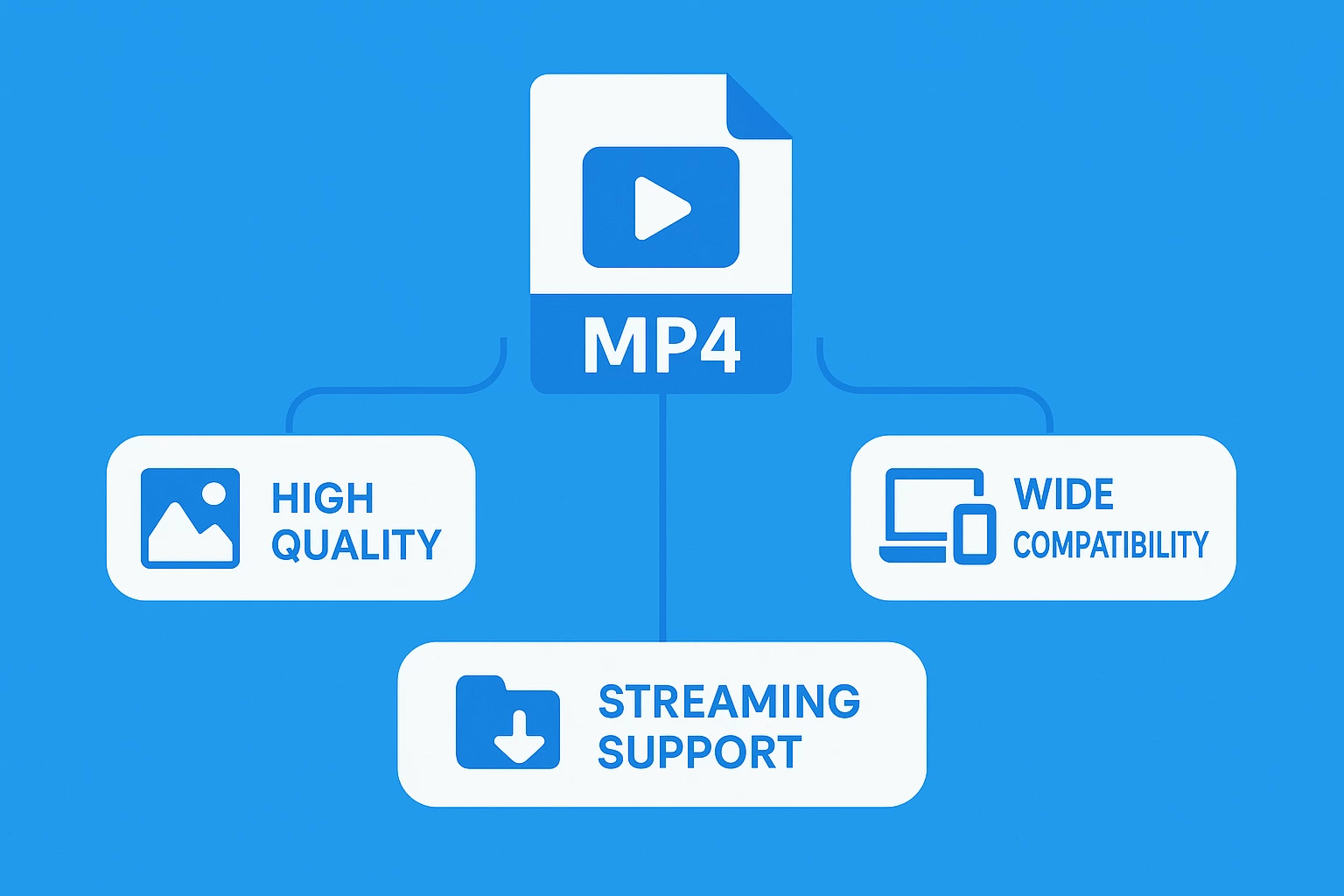
I also appreciate its strength in streaming and sharing. MP4 supports adaptive bitrate streaming, which adjusts video quality automatically based on internet speed. Viewers can start watching instantly without waiting for full downloads.
Finally, MP4 remains storage-friendly and durable. It keeps high-quality visuals at manageable sizes, reduces the need for large storage space, and maintains compatibility with both older and newer systems.
For me, MP4 stands out as the most balanced and reliable format for modern video work. It keeps files small, playback smooth, and distribution effortless across every platform.
Limitations and Challenges of MP4#
Even though MP4 is one of the most practical formats available, it is not perfect. Over time, I’ve learned where it performs well and where it starts to fall short. Understanding its limitations helps me decide when to use it and when to choose a different format for better results.
The most common drawback is lossy compression. MP4 reduces file size by permanently removing parts of the original data. That’s the reason why I usually work in a lossless format, such as MOV or AVI, before exporting the final version to MP4 if projects require high precision or heavy post-production.
Another challenge involves editing efficiency. MP4 files are heavily compressed, so video editors often need to decode them before playback or trimming. This extra step can slow down editing performance, especially with long or high-resolution clips.
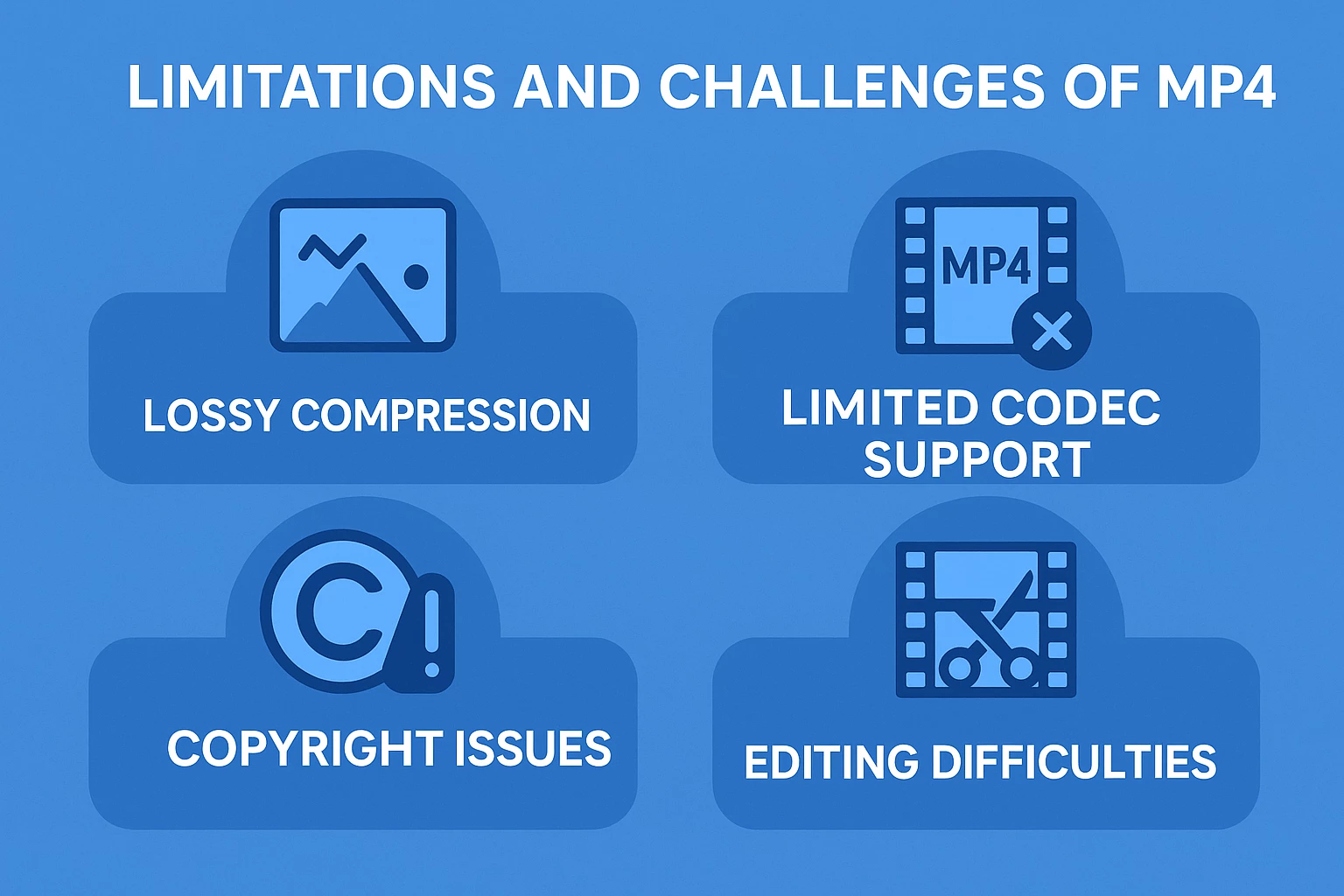
MP4 also lacks advanced transparency and alpha channel support, which limits its use in motion graphics or professional compositing. For projects that rely on transparent overlays or layered effects, I use MOV with ProRes or another format that supports alpha data.
The format’s security and integrity can also present issues. Because MP4 is widely used, it is sometimes targeted by malware or file corruption. I make sure to scan downloaded videos and avoid editing corrupted MP4s, since they can be difficult to repair.
Lastly, MP4 can struggle with very large file sizes or long-duration content. Playback software may experience lag, and transferring such files takes longer. Splitting videos into shorter segments or using adaptive streaming formats usually solves that problem.
Despite these challenges, MP4 remains dependable for everyday use. It is compact, easy to share, and compatible across nearly every platform. I just stay aware of its limitations and switch formats when precision, transparency, or heavy editing are essential.
Also read: What Is a PNG? Benefits, Uses, and When to Use It
MP4 vs Other Video Formats#
MP4 will still hold the top spot as the most widely recognized and versatile video format. It remains the default choice for sharing, streaming, and archiving, yet newer formats have started to push boundaries in specific areas.#
Hence, when I prepare a project for publishing, I often compare MP4 with other options to find the right mix of performance, quality, and workflow efficiency.
MP4 vs MKV#
MKV, or Matroska Video, offers more flexibility when it comes to storing complex media. It can include multiple audio tracks, subtitles, and metadata within one file.
The structure makes it ideal for movies with different languages, director’s commentary, or alternate scenes. MP4, however, stays ahead in compatibility and efficiency. It produces smaller, lighter files that load faster and work seamlessly on almost every platform, from phones to smart TVs.
MP4 vs WebM#
WebM was built for the web and excels at streaming. It uses advanced codecs such as VP9 and AV1, which deliver impressive compression efficiency without noticeable quality loss. I sometimes use WebM for web-based projects because it reduces server load and improves playback speed.
Still, not every editor or older browser supports it perfectly. MP4 remains more dependable when I need universal playback across all systems and software.
MP4 vs MOV#
MOV is the go-to format for professionals who need maximum quality during editing. It supports lossless or lightly compressed video, making it perfect for color grading, compositing, and high-end production.
Often, I use MOV during post-production and then convert the final version to MP4 for distribution. MOV preserves visual accuracy, but MP4 makes delivery and sharing much easier thanks to its smaller file size.
MP4 vs AVI and WMV#
Older formats such as AVI and WMV were once popular but have mostly been replaced. They create large files and struggle with modern codecs, which limit performance and compatibility.
Naturally, MP4 handles the same content more efficiently while maintaining better quality at smaller sizes. I only use those legacy formats for very specific archival or compatibility needs.
So, even with new contenders entering the market, MP4 continues to offer the most reliable combination of quality, compression, and compatibility. It might not achieve the extreme efficiency of WebM or the professional precision of MOV, but it provides consistent performance across every platform and device.
Related article: What Is an Ogg File? Audio Format Explained
How to Create an MP4 File#
Creating an MP4 file is simple since most devices and software already support it. Modern cameras, phones, and screen recorders automatically save videos as MP4, making it the default choice for both professionals and casual users.
In editing software such as Premiere Pro, Final Cut, or DaVinci Resolve, I export videos using the H.264 or H.265 codec with MP4 as the output format. Adjusting bitrate and resolution helps balance quality and file size depending on the platform.
In case converting from other formats, I use reliable converters or online tools and always check the final output for clarity and compression quality.
MP4 remains easy to create, share, and edit, which is why it remains the most practical video format for nearly every purpose.
How to Open and Play MP4 Files#
Opening an MP4 file is effortless since every modern device recognizes it. I can play videos instantly without worrying about special software or file compatibility.
Anyhow, knowing how each platform handles MP4 helps me get the smoothest playback experience. If you often switch between devices or platforms, take a moment to learn how each one handles MP4 playback.
Native Support Across Platforms#
Each operating system handles MP4 playback in its own way, but the experience stays consistent overall. No matter what device I use, the format opens quickly and runs smoothly without extra setup or technical steps.
-
On Windows, the built-in Movies & TV app plays MP4 without any setup, though I often use a third-party player for more control.
-
On macOS, QuickTime Player runs MP4 files seamlessly and supports the most common codecs, including H.264 and H.265.
-
On Android, MP4 plays directly in the gallery or video app, and most messaging platforms rely on it for quick previews.
-
On iOS, the Photos and Files apps open MP4 videos instantly. I usually transfer them through AirDrop or cloud storage without converting.
Best Free and Paid MP4 Players#
While built-in players work fine, I prefer more versatile software for daily use. VLC remains my go-to because it plays nearly everything and rarely fails with unusual codecs. KMPlayer gives me more control over subtitles and audio syncing. 5KPlayer is my choice for large or high-resolution videos, and QuickTime Pro still feels reliable on macOS for editing and exporting.
Each player has strengths, but VLC has never let me down. It runs fast, stays light on resources, and works the same across all platforms.
Troubleshooting Playback Issues#
Sometimes an MP4 file refuses to play properly. Missing audio, lag, or “unsupported codec” messages usually point to corrupted data or outdated software. I start by updating the player and, if needed, installing the latest codec pack.
If the problem persists, I convert the file to a different MP4 variant or re-encode it for compatibility. Lowering resolution also helps when my device struggles with high-bitrate videos.
Most playback issues are easy to fix once I confirm the player and codecs are current. MP4 continues to be one of the least troublesome formats I’ve ever worked with.
How to Convert MP4 Files#
Converting an MP4 into another format can save space, make editing easier, or ensure compatibility with specific platforms. I often work with MOV, MKV, or AVI, depending on the project.
So finding a tool that handles conversions quickly without losing quality makes a big difference.
In this case, MConverter is the best solution. Our platform is secure & browser-based and is designed to simplify video conversion without requiring installation or complicated settings.
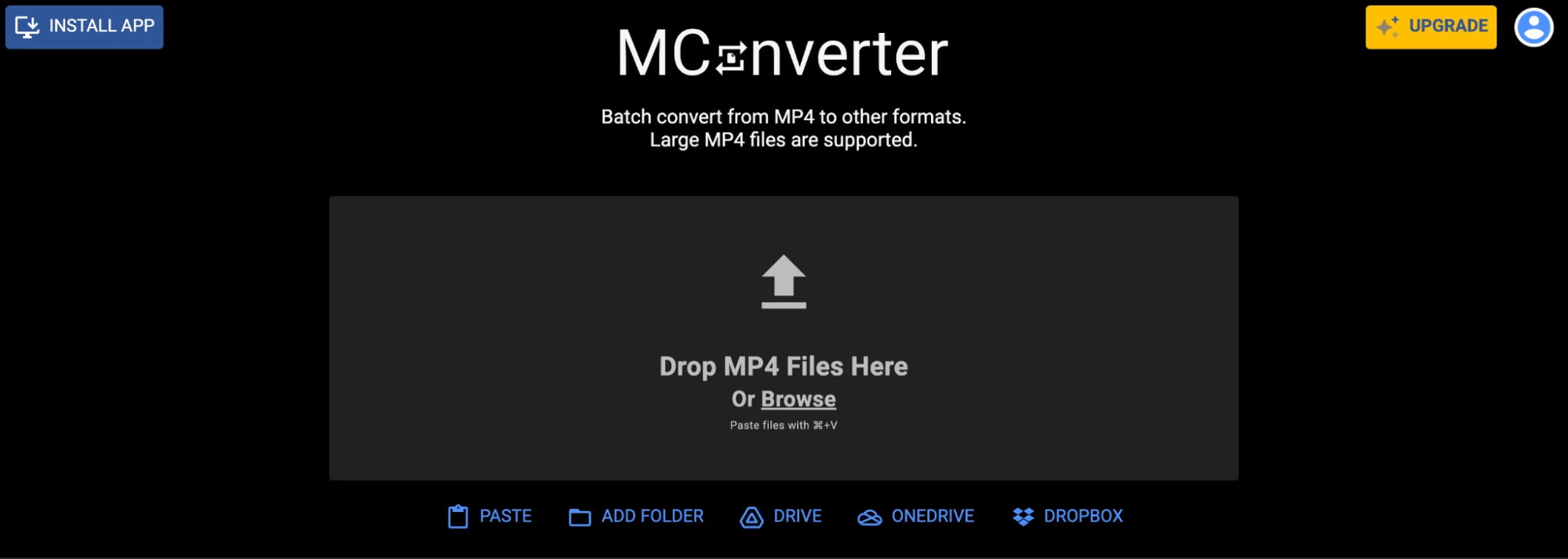
Simply, I can upload any MP4 file, choose the output format I need, and download the converted version in seconds. The process keeps the image sharp, the sound clean, and automatically deletes files later to protect privacy.
What you’d appreciate most is the speed and reliability. Even large files convert smoothly, and you won’t have to worry about pop-ups or data loss. It works on any device and supports multiple file types, which makes it ideal for professionals and casual users alike.
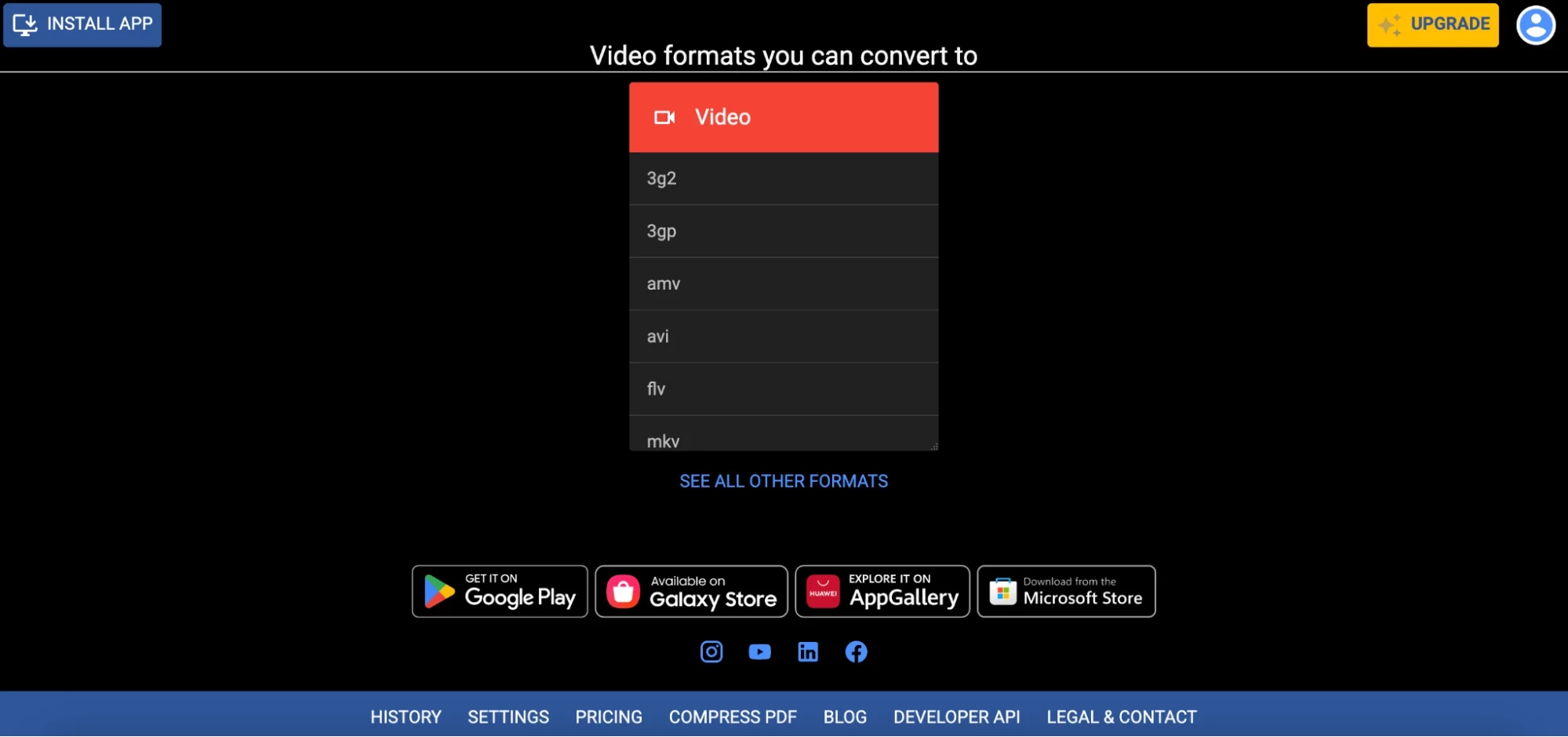
If you need a dependable way to convert videos, MConverter is worth trying. It’s crafted for people who want quick results without trading away quality or security.
Security and Privacy in MP4 Files#
MP4 files are safe when handled correctly, but I never assume every file is clean. A video from a trusted source is usually fine, while random downloads or email attachments can include hidden risks. I always check where a file comes from before opening it.
Most MP4 security problems come from distribution, not from the format itself. Scanning a file before use takes only a few seconds and helps avoid damaged or infected content.
MP4 files can also contain metadata such as location, device type, or editing history. Before uploading or sharing, I remove that information to protect personal and project data.
Good habits keep MP4 files safe. I verify sources, scan files when needed, and clear metadata before sharing. Those small steps keep every project private and secure.
MP4 in the Age of AI and Streaming (2025 Trends)#
MP4 still leads the way in digital video, but the technology around it has evolved significantly. As AI and modern streaming systems continue to advance, they now handle optimization, compression, and playback with far more precision than before.
Today, AI plays a major part in how MP4 files are compressed and optimized. Instead of applying the same settings to every frame, new tools analyze each scene and decide where to keep or reduce data.
As a result, fast motion receives more detail, while static sections use less. Its balance creates smaller files that still look sharp and load quickly across all devices.
Moreover, AI compression tools now clean up older or low-quality MP4s more effectively. They correct color balance, reduce noise, and restore lost detail without needing a full re-export.
Building on that progress, predictive encoding goes further by adjusting compression and resolution based on how a video is likely to be viewed. In the same way, AI-powered upscaling makes older videos look clear on modern screens with minimal quality loss.
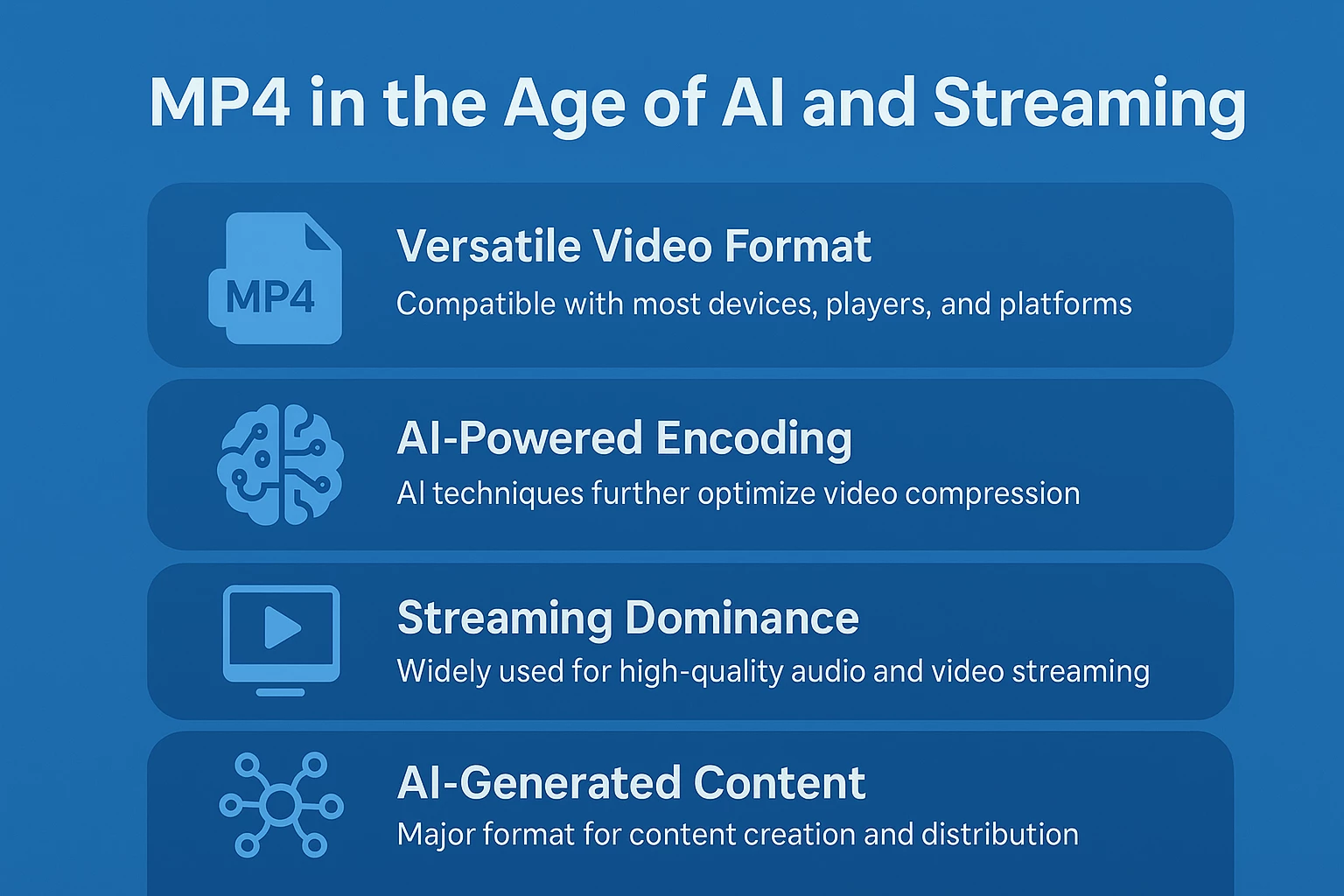
At the same time, streaming platforms continue to rely on MP4 because it remains stable, efficient, and universally compatible. Netflix, YouTube, and Vimeo still use MP4-based formats along with newer codecs such as H.265 and AV1 to deliver strong image quality while keeping bandwidth low.
In addition, adaptive bitrate systems such as HLS and DASH automatically switch between different MP4 versions during playback, keeping videos smooth even with fluctuating internet speeds.
Overall, in 2025, MP4 stands as a format shaped by both AI and streaming innovation. Through smarter compression, predictive optimization, and adaptive delivery, it remains a reliable standard for creators, platforms, and viewers everywhere.
Also read: Is Convertio Safe? Honest Review
Is MP4 Better Than MOV for Editing?#
Not always. MP4 is smaller and easier to share, which makes it great for distribution. MOV, however, is often preferred for editing because it retains higher quality and uses less compression. Most professional video editors use MOV during production and then export the final version as MP4 for publishing or online use.
Can I Compress MP4 Without Losing Quality?#
Yes, but only to a point. You can reduce file size by adjusting bitrate, resolution, or codec settings while keeping the visual difference minimal. Using tools that support high-efficiency codecs like H.265 helps achieve smaller MP4 files with almost no visible loss in quality. However, heavy compression will always remove some detail.
Are MP4 Files Safe to Download From the Internet?#
Generally, yes, MP4 files are safe to download if they come from reliable sources. The format itself cannot harm your device, but malicious actors can disguise harmful code inside a fake video file. To stay safe, I always download MP4s from trusted platforms and run a quick antivirus scan before opening them.
Can MP4 Files Contain 4K or Hdr Video?#
Yes. MP4 fully supports 4K and HDR video as long as the right codec, such as H.265 (HEVC) or AV1, is used. Many modern cameras, phones, and streaming services already record or deliver 4K HDR content in MP4 format. The key factor is the codec, not the container, so playback quality depends on both the file and the device’s capabilities.
About the author
Mihael joined MConverter as a co-founder in 2023, bringing a vision to transform a tech tool into a product company built around meaningful user experience. With roots in B2B sales, product development, and marketing, he thrives on connecting the dots between business strategy and customer needs. At MConverter, he shapes the bigger picture - building the brand, inspiring teams, and pushing innovation forward with a can-do mindset. For Mihael, it’s not just about file conversions, but about creating experiences that deliver real impact.
Check out more articles
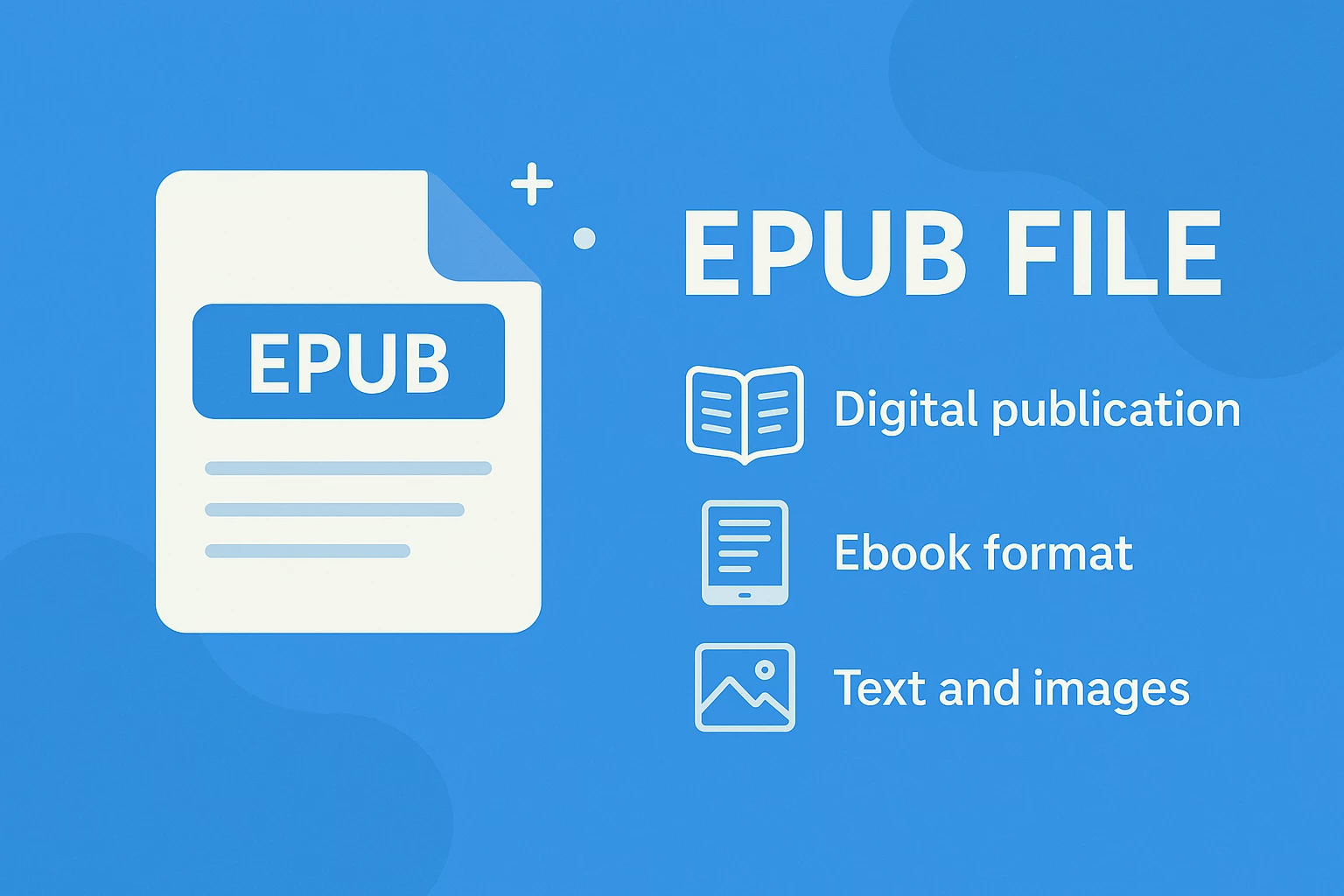
EPUB Files - What They Are & How to Open Them

What Is an ISO File? The Ultimate Guide for 2025
